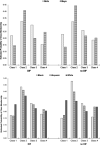Latent classes of aggression and peer victimization: Measurement invariance and differential item functioning across sex, race-ethnicity, cohort, and study site
- PMID: 34676893
- PMCID: PMC9297936
- DOI: 10.1111/cdev.13691
Latent classes of aggression and peer victimization: Measurement invariance and differential item functioning across sex, race-ethnicity, cohort, and study site
Abstract
Peer victimization is common and linked to maladjustment. Prior research has typically identified four peer victimization subgroups: aggressors, victims, aggressive-victims, and uninvolved. However, findings related to sex and racial-ethnic differences in subgroup membership have been mixed. Using data collected in September of 2002 and 2003, this study conducted confirmatory latent class analysis of a racially-ethnically diverse sample of 5415 sixth graders (49% boys; 50.6% Black; 20.9% Hispanic) representing two cohorts from 37 schools in four U.S. communities to replicate the four subgroups and evaluate measurement invariance of latent class indicators across cohort, sex, race-ethnicity, and study site. Results replicated the four-class solution and illustrated that sociodemographic differences in subgroup membership were less evident after accounting for differential item functioning.
© 2021 The Authors. Child Development published by Wiley Periodicals LLC on behalf of Society for Research in Child Development.
Figures




Similar articles
-
Challenging the "'Mean Kid"' Perception: Boys' and Girls' Profiles of Peer Victimization and Aggression from 4th to 10th Grades.J Interpers Violence. 2022 Sep;37(17-18):NP15095-NP15129. doi: 10.1177/0886260521997949. Epub 2021 Mar 14. J Interpers Violence. 2022. PMID: 33719703 Free PMC article.
-
Individual and contextual factors associated with patterns of aggression and peer victimization during middle school.J Youth Adolesc. 2013 Feb;42(2):285-302. doi: 10.1007/s10964-012-9854-8. Epub 2012 Nov 17. J Youth Adolesc. 2013. PMID: 23160659
-
Sexual Aggression and Victimization Among Adolescents in School: Using a MixIRT Analysis to Examine Measurement Equivalence.Aggress Behav. 2025 Mar;51(2):e70022. doi: 10.1002/ab.70022. Aggress Behav. 2025. PMID: 40114322 Free PMC article.
-
Using Three Reporters to Identify Pre-Adolescent Peer Victims through Latent Profile Analysis.Res Child Adolesc Psychopathol. 2021 Jun;49(6):737-748. doi: 10.1007/s10802-021-00768-2. Epub 2021 Feb 3. Res Child Adolesc Psychopathol. 2021. PMID: 33534095
-
Bullying and victimization among adolescents: the role of ethnicity and ethnic composition of school class.J Youth Adolesc. 2010 Jan;39(1):1-11. doi: 10.1007/s10964-008-9355-y. Epub 2008 Oct 24. J Youth Adolesc. 2010. PMID: 20091212 Free PMC article.
Cited by
-
Long-term consequences of bullying involvement in first grade.J Sch Psychol. 2023 Apr;97:63-76. doi: 10.1016/j.jsp.2023.01.004. Epub 2023 Feb 2. J Sch Psychol. 2023. PMID: 36914367 Free PMC article. Clinical Trial.
-
Polysubstance Use among Maryland High School Students: Variations across County-Level School Districts.Int J Environ Res Public Health. 2024 May 17;21(5):639. doi: 10.3390/ijerph21050639. Int J Environ Res Public Health. 2024. PMID: 38791853 Free PMC article.
References
-
- Bettencourt, A. F. , Musci, R. , Clemans, K. , Carinci, J. , & Ialongo, N. (2017). Patterns of peer‐ and teacher‐rated aggression, victimization, and prosocial behavior in an urban, predominantly African American preadolescent sample: Associations with peer perceived characteristics. Journal of School Psychology, 65, 83–101. 10.1016/j.jsp.2017.07.003 - DOI - PubMed
-
- Bradshaw, C. P. , Schaeffer, C. M. , Petras, H. , & Ialongo, N. (2010). Predicting negative life outcomes from early aggressive‐disruptive behavior trajectories: Gender differences in maladaptation across life domains. Journal of Youth and Adolescence, 39, 953–966. 10.1007/s10964-009-9442-8 - DOI - PubMed
MeSH terms
LinkOut - more resources
Full Text Sources
Medical

